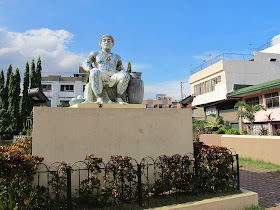The last time I visited Canada was in October 2007, and I don't know if it was the colder weather that gave me the impression that Canada was slightly depressed. By this I mean the place and people looked sadder than now. I must say that this visit, Toronto and Montreal seem very vibrant and optimistic.

The weather this last day of July has been warm and pleasant; and it's delightful to see people in summer clothes basking in parks and sidewalk benches. This is wonderful summer weather.
Today, we went on a pilgrimage to St. Joseph's Oratory on Mount Royal, the largest church in Canada. The Basilica is huge, towering on the mount so one has wonderful views of Montreal from above. There are two levels to the Basilica; and there are many areas for prayer in the complex. The bottom floor has the crypt of St. Andre Bessette, a humble brother who had a devotion to St. Joseph. It is said that he was prompted to build a church in honor of St. Joseph, and he placed a statue of St. Joseph on the ground and told the saint that if he wanted a roof over his head, he would have to help. A chapel was built, then a church, and now the huge basilica stands. The feeling of holiness and peace permeate the Basilica.

Aside from the crypt, there is a church in the bottom floor. Upstairs is the Basilica proper, a huge handsome modern church. Outside there is a small chapel honoring St. Andre.

After praying, we had lunch and proceeded downtown to visit the Underground City. There is something like 40 kilometers of interconnected complexes that exist under Montreal. In the winter, this is practical as it is warmer underground; and some 500,000 people use the Underground City during this time of year. A man reportedly lived for seven years underground.
















































